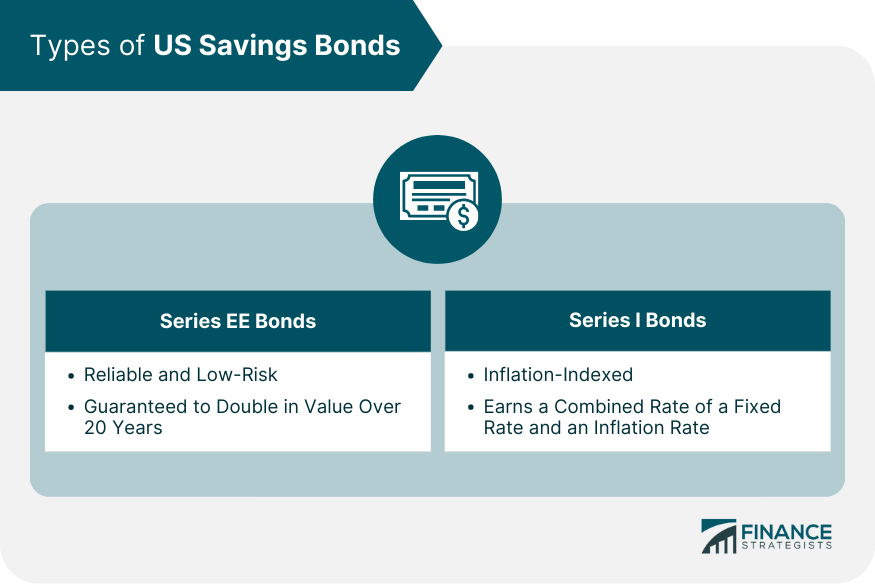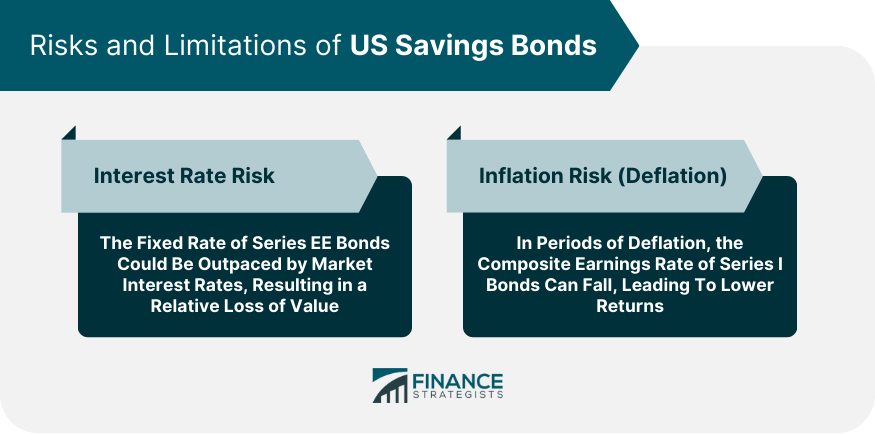U.S. Savings Bonds are a type of investment vehicle offered by the United States government. They are considered one of the safest forms of investment available to individual investors. U.S. Savings Bonds are designed to provide a low-risk way for individuals to save money over a fixed period while earning interest on their investment. The U.S. Department of the Treasury issues Savings Bonds to raise funds for government spending and finance various projects. These bonds are essentially loans made by individuals to the government, with the promise of repayment along with interest. The interest rates for Savings Bonds are typically lower compared to other investments but are guaranteed by the U.S. government, making them highly secure. Series EE Bonds are reliable, low-risk products. They guarantee to double in value over the term of the bond, typically 20 years. The interest rate for Series EE Bonds is fixed upon purchase, providing a level of security against fluctuating market conditions. They are an excellent option for long-term savers who want a guaranteed return on their investment. Series I Bonds are inflation-indexed. They earn a combined rate consisting of a fixed rate, which remains the same for the life of the bond, and the inflation rate, adjusted semiannually. This combination allows the bonds to maintain their purchasing power over time despite inflation, which makes them a valuable financial instrument in an investor's portfolio, especially in times of increased inflation. U.S. Savings Bonds earn interest in a unique way. The Treasury Department issues them at face value, and the bonds accrue interest over time. The accrued interest is paid to the bondholder upon redemption of the bond. The U.S. Treasury offers a Savings Bond Calculator on the TreasuryDirect website. This tool helps you determine the current value of your savings bonds. Predicting the future value of savings bonds can be tricky due to changing interest rates. However, as long as you hold onto a Series EE bond for 20 years, you are guaranteed to double your initial investment. U.S. Savings Bonds are easily accessible to the average citizen. They can be purchased online through TreasuryDirect, a website operated by the U.S. Department of the Treasury. Additionally, savings bonds can make an excellent gift for a child or grandchild to help them start on the path to financial literacy and security. Companies also have the option to offer savings bonds to their employees through payroll deductions, and bonds can be bought with your tax refund at tax time. Most U.S. Savings Bonds need to be held for a minimum of one year before they can be cashed. After that, they can be redeemed at any time. However, cashing a bond within the first five years will result in a penalty of the last three months' interest. To cash a bond, you can visit a financial institution or mail them to Treasury Retail Securities Services. Electronic bonds can be redeemed through the TreasuryDirect website. Interest earned from savings bonds is subject to federal tax, but it is not taxed until the bond is cashed or stops earning interest after 30 years. In terms of state and local taxes, U.S. Savings Bonds are exempt from both state and local tax. One strategy is to use the bonds for educational purposes. The Education Savings Bond Program allows for tax-exemption if the bonds are used for eligible education expenses. Alternatively, you may choose to defer reporting the interest earned on your tax return until the bond is redeemed or stops earning interest. The Education Savings Bond Program is an incentive to help parents and students save for education costs. It allows the interest earned on both Series EE and I bonds to be excluded from federal income tax if the bond redemption proceeds are used for qualified higher education expenses at an eligible institution. Bondholders can redeem their bonds and use the proceeds to pay for tuition and fees at eligible post-secondary institutions. The tax exclusion is subject to modified adjusted gross income (MAGI) limits and can be gradually reduced for MAGIs within a certain range. The tax exclusion for educational expenses is a significant benefit of using U.S. Savings Bonds for education. This can lead to substantial savings, particularly for families in higher tax brackets. While Series EE bonds offer a fixed rate, the risk lies in the potential of market interest rates exceeding the bond's fixed rate during its term. Although Series I bonds provide some protection against inflation, in periods of deflation, the composite earnings rate can fall, resulting in a lower return. Unlike volatile stocks and mutual funds, savings bonds offer a safer, albeit lower return. The choice between the two depends on your risk tolerance and investment horizon. Like savings bonds, certificates of deposit (CDs) are relatively low-risk investments. However, CDs typically have a set term, and early withdrawal can result in penalties. Savings bonds, while having penalties for early withdrawal, do not have a set term and continue to earn interest for up to 30 years. Other Treasury securities, like Treasury Bills or Notes, differ in their terms and the way they pay interest. While savings bonds accrue interest until redemption or maturity, other Treasury securities typically pay interest semi-annually. Despite their low yield compared to other investments, U.S. Savings Bonds have a role in a diversified portfolio due to their low risk and guaranteed return. They can serve as a steady, conservative component amidst more volatile investments. U.S. Savings Bonds are a type of debt security issued by the Department of the Treasury. They serve as a safe and convenient way for individuals to invest their money, providing guaranteed returns over time. Understanding their value involves recognizing that they accrue interest until maturity or redemption, with the current value easily calculated via tools such as the TreasuryDirect Savings Bond Calculator. However, they do carry certain risks and limitations, including the interest rate risk and potential for lower returns during deflationary periods. Additionally, purchase and ownership limits apply. Despite these considerations, U.S. Savings Bonds remain a steady, secure investment tool for those seeking a balance of risk and reward in their financial planning endeavours. They represent a tangible commitment to long-term savings and an opportunity to support the borrowing needs of the U.S. government.Definition of US Savings Bonds
Types of US Savings Bonds
Series EE Bonds
Series I Bonds

Value of US Savings Bonds
How US Savings Bonds Earn Interest
Determining the Current Value
Predicting Future Value
Purchasing US Savings Bonds
Redeeming US Savings Bonds
When Can You Cash US Savings Bonds?
How to Cash US Savings Bonds
Tax Implications of US Savings Bonds
Federal, State, and Local Tax Considerations
Strategies for Minimizing Tax on US Savings Bonds
US Savings Bonds and Education
Education Savings Bond Program
How to Use US Savings Bonds for Education Expenses
Tax Benefits for Education
Risks and Limitations of US Savings Bonds

Interest Rate Risk
Inflation Risk
Comparing US Savings Bonds With Other Investment Options
US Savings Bonds vs Stocks and Mutual Funds
US Savings Bonds vs Certificates of Deposit (CDs)
US Savings Bonds vs Treasury Securities
Role of US Savings Bonds in a Diversified Portfolio
Conclusion
US Savings Bonds FAQs
A U.S. Savings Bond is a debt security issued by the Department of the Treasury. Available in Series EE and Series I, these bonds offer a secure investment option that either provides guaranteed returns (Series EE) or offers protection against inflation (Series I).
U.S. Savings Bonds can be purchased online through the TreasuryDirect website, a platform managed by the U.S. Department of the Treasury. Additionally, they can be purchased as gifts or through payroll deductions, and even with your tax refund.
The value of a U.S. Savings Bond grows over time as it accrues interest. The interest is either fixed for the life of the bond (Series EE) or adjusted semiannually with inflation (Series I).
While U.S. Savings Bonds are generally considered a low-risk investment, there are some risks and limitations. For instance, market interest rates might surpass the fixed rate offered by Series EE bonds, and deflation can impact Series I bonds. Also, there are annual purchase limits and penalties for early cash out.
Compared to stocks and mutual funds, U.S. Savings Bonds offer lower returns but have less risk. Unlike CDs, which have a set term, savings bonds earn interest up to 30 years. Compared to other Treasury securities, savings bonds are unique because they accrue interest until redemption or maturity, while most other Treasury securities pay interest semiannually.
True Tamplin is a published author, public speaker, CEO of UpDigital, and founder of Finance Strategists.
True is a Certified Educator in Personal Finance (CEPF®), author of The Handy Financial Ratios Guide, a member of the Society for Advancing Business Editing and Writing, contributes to his financial education site, Finance Strategists, and has spoken to various financial communities such as the CFA Institute, as well as university students like his Alma mater, Biola University, where he received a bachelor of science in business and data analytics.
To learn more about True, visit his personal website or view his author profiles on Amazon, Nasdaq and Forbes.











